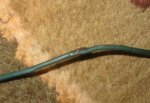Re: Won't rev past 2500
What size boat and what size prop? The Chrysler 140 in stock form was not 140, had a high lower unit gear ratio, and can easily be overpropped.
Secondly, Top cylinder is #1. You should have two fuel pumps in series--first one on bypass cover #3 feeding the second one on bypass cover #2. The 140 is a thirsty engine and it takes two pumps to adequately supply those massive carbs. (should be TC5E with .096 jets) If either fuel pump is not performing at peak delivery, the top speed will suffer. NOTE: Since both carbs run lean in this circumstance, the engine loses power on all cylinders and there is less danger of detonation than if only one carb runs lean--but the danger is still there. So: If the engine flattens out when you hit the throttle, back off right away. Replace BOTH diaphragms and both of the gaskets. See if that doesn't help. Correct installation is: Diaphragm goes against the removable pump part and the gasket goes on top of the diaphragm. then the whole thing is screwed to the bypass cover.
EDIT--Additional thought--Remove and clean both screens from the black plastic fuel inlet covers on both pumps. Only replace the screen on the first pump (#3 bypass). Reasoning: Anything that gets through the first screen will also get through the second. The second screen does nothing but add resistance to fuel flow. Oh, Yeah: If your engine has alot of hours on it, run a pipe cleaner through the large circle diaphragm pressure/vacuum actuating hole to be certain it is not clogged. It is a hole about 3/16 diameter in the bypass cover right about center of the large portion of the diaphragm.
And as a precaution, to prevent crap from the pumps from getting into and clogging the carbs, put a cheap 3 buck plastic fuel filter between the final pump and the carbs. This will help to prevent a lean run on one carb, resulting detonation, and melted pistons. 3 bucks save about a thousand. That's a deal!
Want to see something dramatic? With the carb covers off, have someone nail the throttle while you look into the carbs--Surprising the amount of fuel delivered, isn't it?
BTW: That diaphragm and gasket was the same part for all engines up to at least Force 1990 so ask for the diaphragm for a 1990 Force 125 at your Merc Dealer--they will not have records for a 79 Chrysler and will just tell you they can't get it.
Be certain the timing is at 32 or 30 degrees advanced at full throttle. Late or advanced timing can reduce performance. Your engine was timed at 32 but later engines were reduced to 30 so either is acceptable.
Later, when you get the engine performing up to snuff, you can switch the oil recirculation nipples from the bypass covers to the manifolds. The extra oil on the reeds promotes better sealing and you should gain a few hundred RPM and a couple of MPH at top end. Come back then and I will fully describe the modification and both positive and negative consequences.
BTW: That's MY 78-79 Chrysler 140 in the avatar. turns a 13 X 19 cupped stainless Michigan prop at 5000 with 38 MPH top speed GPS on a 21 foot Manatee cuddy. --But I re-worked it.





















